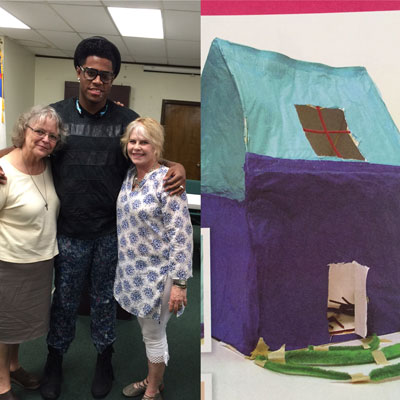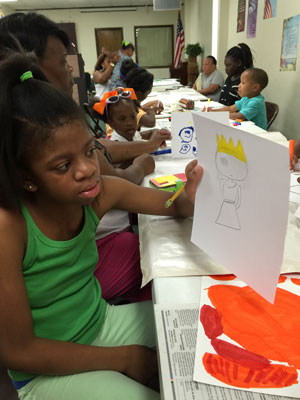
Photo courtesy of Karla Leopold
Idyllwild resident and art therapist Karla Leopold went to Louisiana in 2005 shortly after Hurricane Katrina had devastated New Orleans. With the assistance of Rosie O’Donnell’s “Project Katrina,” Leopold led a team of art therapists to an evacuation center north of Baton Rouge. Their mission was to use art to help survivors process the emotional and physical trauma they had experienced.
She returned in 2015 on the 10th anniversary of Katrina’s Aug. 29 landfall. She hoped, along with Sister Judith Brun of the Baton Rouge Area Foundation, to reunite with Katrina survivors and once again use art to capture and chronicle survivors’ experiences.
She remembered from her first trip a young boy named Jamal. “He was nine when Katrina struck,” she said. “He and his father, brother and stepmother were among the last to be rescued by helicopter five days later. They were on the roof of their flooded house, having cut a hole in the ceiling to escape the rising waters. It was their window to the sky and to their survival.”
Leopold recalled her team’s work in 2005 at Renaissance Village, an evacuation camp north of Baton Rouge. They used art to help young survivors transfer their fears, memories, pain and loss onto paper and into art projects — where words might be difficult, locked away behind a barrier of pain, drawing or painting might be easier. She recalled Jamal’s drawings. “He drew bathrooms on tops of houses because for so many days he and his family had been trapped on the roof of their house with no bathroom while waiting for rescue. After that he spent many days building what he called his ‘ant house.’ He used layers and layers of crepe paper and glue to make a house with a square hole in the roof and an ant on the ground floor. The hole was the escape route to the roof the family had used. The ant was there because Jamal said he felt like an ant and it would not be long before he would be stepped on.”
Leopold’s return in 2015 was part of a project to document the experience of survivors 10 years later. There were going to be interviews conducted by a Ph.D. student but Leopold felt there should also be some ceremony as well. “I went back because I felt we needed to do something to honor those survivors,” she said. “Sister Judith knew a pastor of a church close to where Renaissance Village had been. He agreed to host an event and to help us find survivors who might still be in the area. We went door to door in housing developments near the church hoping to find anyone who had survived Katrina or knew survivors.
“We found a woman who had been at Renaissance Village and she agreed to help us find others. We had no idea how many might come. I was thinking we’d be lucky to find 10. Forty came — forty people who had survived Katrina. And one of them was Jamal.” Leopold described the reunion with Jamal. “It was wonderful to see him. He is now working with homeless youth.”
Leopold asked everyone at the reunion event to draw their lives, then and now. “We couldn’t give out the paper and colored markers fast enough,” she said. “We had to

Photo courtesy of Karla Leopold.
send out for more supplies.” She described an older couple, in their 70s, who had been sitting quietly at the end of one of the tables. “I asked them to map their journey. They had lost everything. They had been to six different places, beginning with Houston. And, like many, they did not return to New Orleans. The ones who did were ones who were financially able to do so. Most of the poorer survivors now live in the Baton Rouge area.
“You always wonder if your work makes a difference. At the time we didn’t know, but in our hearts we knew what we were doing was right. Hopefully, through the documentation of what we did there over the three years we kept returning and working with survivors, people will have a better understanding of childhood trauma.”
While there for the 2015 reunion, Leopold and Sister Judith were asked by National Public Radio to record their Katrina story for “StoryCorps,” a nonprofit project whose mission is to honor and celebrate the lives of everyday Americans by listening to their stories. “Our experiences are now recorded at the Library of Congress and my great-grandchildren will be able to hear my voice and know our story.”
Leopold is a respected and honored artist, having won prestigious awards. But for her, Katrina has meant the most. “As far as my life goes, this has been the biggest art piece in my life. Just have the courage to follow your heart, even if not sure of what or how you’re doing.”










